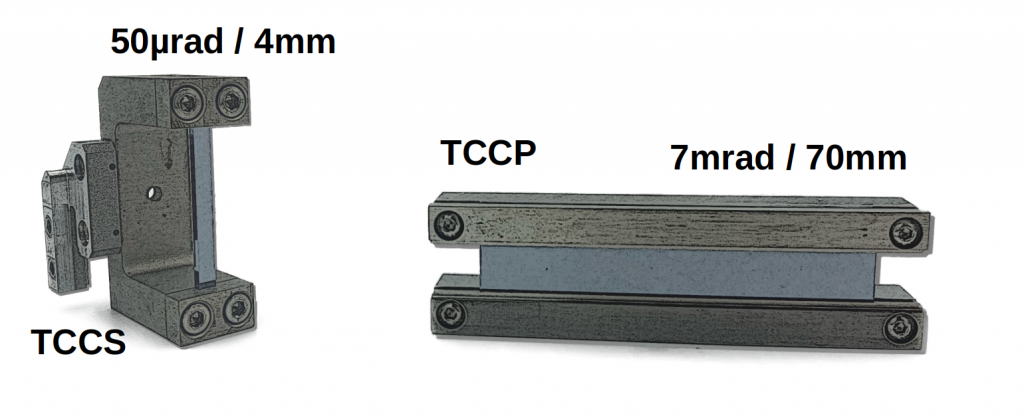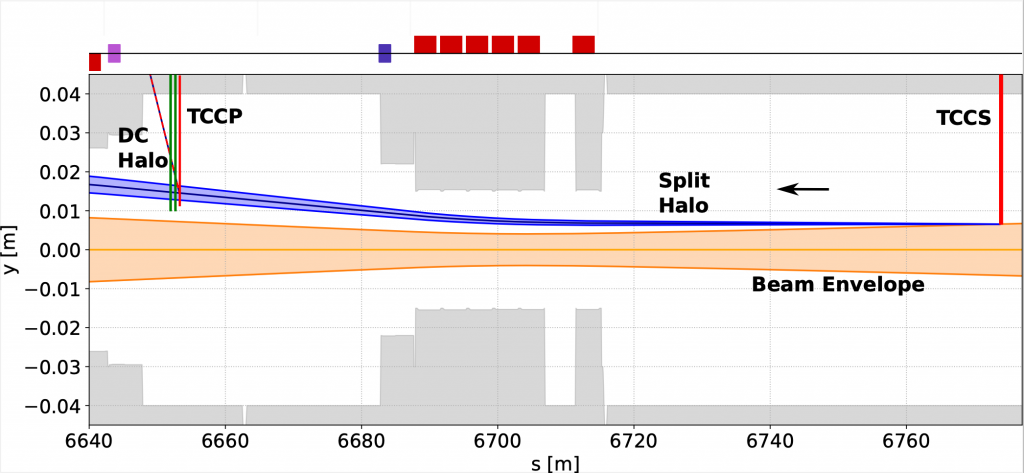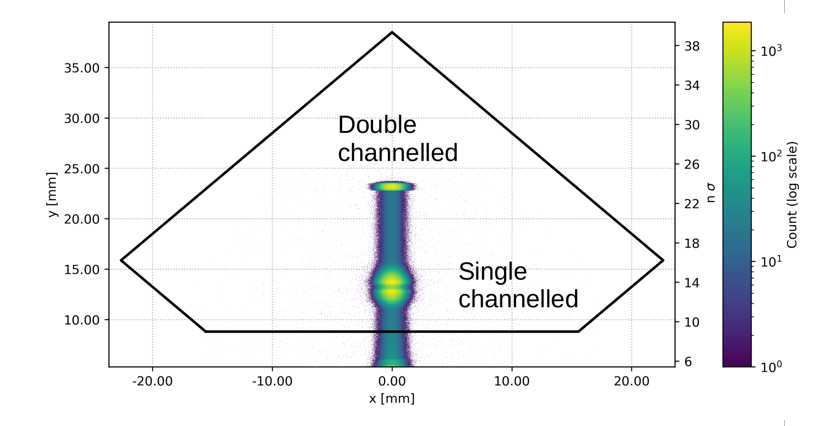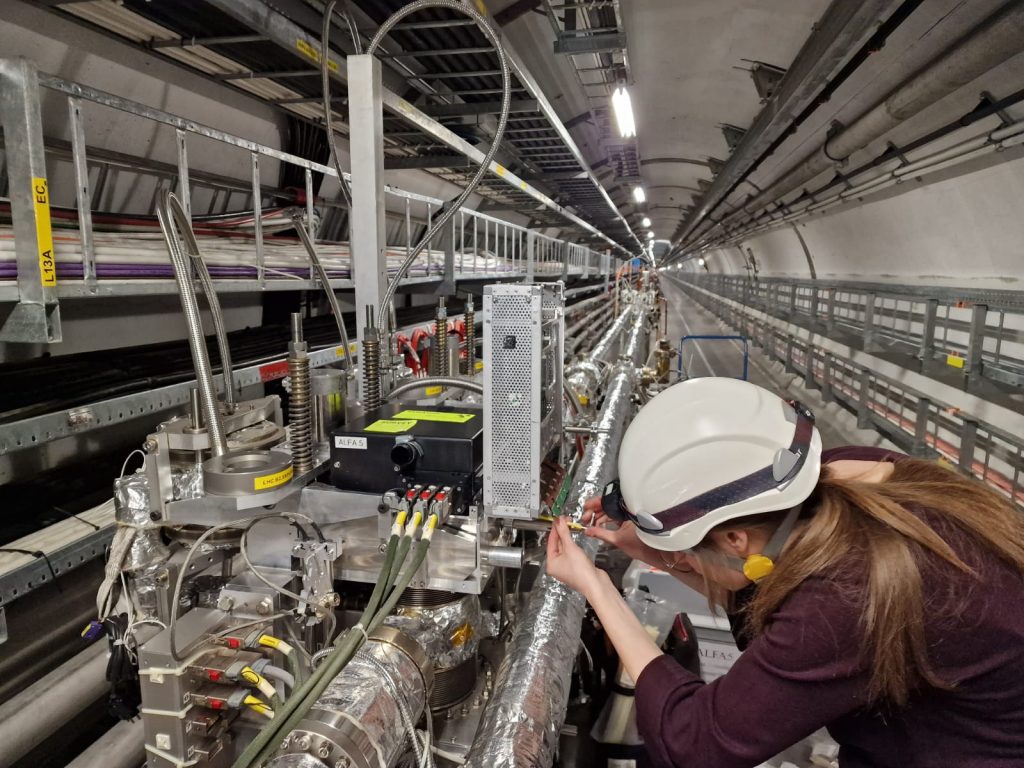TWOCRYST: A Proof-of-Principle Experiment for Crystal-Based EDM/MDM Measurements of Charm Baryons
by Pascal Hermes, on behalf of the TWOCRYST Collaboration
TWOCRYST is entering its final phase of preparation at the CERN Large Hadron Collider (LHC). Its goal is to demonstrate a novel method for studying the electric and magnetic dipole moments (EDM/MDM) of extremely short-lived particles. TWOCRYST serves as a critical testbed for the ALADDIN experiment (An LHC Apparatus for Direct Dipole moments INvestigation), which has been recently proposed to the LHCC with the aim to measure the spin precession of charm baryons—particularly the Λc+—at the LHC in Run4. The challenge for this measurement is that these particles have lifetimes of just 10⁻¹³ seconds, making the use of conventional magnets practically impossible.
ALADDIN relies on a fixed target and a long bent silicon crystal to produce and steer Λc+ particles. A bent crystal can guide charged particles along its atomic planes – the so-called “channelling” phenomenon – inducing significantly stronger deflections than achievable with magnets. The resulting spin precession encodes information about the particle’s fundamental properties. A downstream detector captures the decay products to extract these observables.
From Halo to Λ: The Double-Crystal Setup

The ALADDIN concept repurposes beam halo protons— particles that would otherwise be lost in the collimation system —for fixed-target collisions. A short crystal (TCCS) first deflects these protons onto a fixed target, producing Λc+ baryons. A second, longer crystal (TCCP) then channels some of the resulting Λc+particles. The strong electromagnetic fields inside the bent crystal induce the spin precession.
Designed to run parasitically using beam halo particles, the setup can extend the physics reach of the LHC without impacting the statistics of the main experimental program.
Why TWOCRYST?
Before deciding on the implementation of a new physics experiment, several questions must be answered: Can a long bent crystal like the TCCP effectively channel multi-TeV particles like the Λc+ baryons created in ALADDIN? Is the flux of halo protons sufficient to produce useful rates of Λc+? And can both crystals be simultaneously aligned to the beam with the required microradian precision?

Courtesy of A. Mazzolari, INFN Ferrara
To address these challenges, the TWOCRYST experiment was launched in 2023 and now brings together over sixty scientists in an international collaboration. It replicates the core layout of ALADDIN using two bent crystals (Figure 2) and two 2D tracking detectors housed in Roman Pots, installed in Insertion Region 3 (IR3) of the LHC.
The goal is to perform tests with the LHC beams to validate the crystal performance, test alignment during operation, and measure the achievable particle rates on the target—all ahead of the High-Luminosity LHC (HL-LHC) upgrade during Long Shutdown 3 (LS3).
Implementing the Setup in IR3
LHC IR3, hosting a part of the collimation system, was chosen for its available space, low radiation levels, and improved performance compared to the initially studied implementation close to LHCb. Beam dynamics simulations determined the optimal positions for the TCCS, TCCP, and detectors along the LHC Beam 2 line.
In the planned configuration, halo protons are channelled by the TCCS onto the TCCP which may channel them a second time. A downstream detector records their impact positions. Two separate clusters—single-channelled and double-channelled particles—are expected, allowing direct measurement of the TCCP’s channelling efficiency (Figures 2–3).


Hardware Highlights
The bent crystals are made from ultra-pure silicon with extremely low defect density. Their performance was validated with X-ray scans and beam tests at CERN’s North Area. The TCCS goniometer was reused from a previous LHC installation. A new goniometer was designed and constructed for the heavier TCCP crystal, capable of positioning it with micrometre accuracy and integrating a target just 0.2 mm from the crystal surface.
TWOCRYST uses two high-resolution 2D tracking detectors: a Silicon Pixel Detector based on an LHCb VELO tile, and the TWOCRYST Fibre Tracker (TFT), a refurbished ATLAS-ALFA detector. Both are housed in Roman Pots recovered from ATLAS-ALFA, which minimized development time and cost.

Installation and First Results

By early 2025, all components were installed and connected, including motion controls, vacuum, cooling, and monitoring systems. Hardware tests confirmed full functionality of all devices, and stable detector performance.
After commissioning, the first beam-based tests
were performed using LHC halo protons. A major early success came with the clear observation of channelling in TCCS, paving the way for full operation with both crystals later in the year.
Looking Ahead
With commissioning nearly complete, TWOCRYST is set to begin its full measurement campaign in summer 2025. The results will be crucial for assessing the feasibility of ALADDIN and advancing the development of crystal-based fixed-target experiments at the HL-LHC. If successful, this work could enable the first precision measurements of EDM and MDM in charm baryons, probing fundamental particle properties at an unprecedented level and potentially revealing new physics beyond the Standard Model.
Acknowledgments
The implementation of TWOCRYST was made possible thanks to the excellent and tireless efforts, as well as the hardware and financial contributions, of the entire TWOCRYST collaboration, which brings together the institutes CERN, INFN (Italy), IFIC (University of Valencia-CSIC, Spain), IJCLab (France), the University of Malta, the Institute of Nuclear Physics of the Polish Academy of Sciences (Poland), UCAS (China), and Warsaw University of Technology (Poland).
Colleagues across several CERN departments were involved with crucial contributions, most notably BE, TE, EN, EP, and SY. TWOCRYST received substantial support from the Physics Beyond Colliders Study Group. The project was supported by the HL-LHC project and the ATLAS-ALFA collaboration and by the ERC SELDOM Consolidator Grant G.A. n. 771642, project AICRYSCON financed by Xjenza Malta, for and on behalf of the Foundation for Science and Technology, through the FUSION: R&I Research Excellence Programme.
Further Reading: twocryst.web.cern.ch https://aladdin.web.cern.ch/